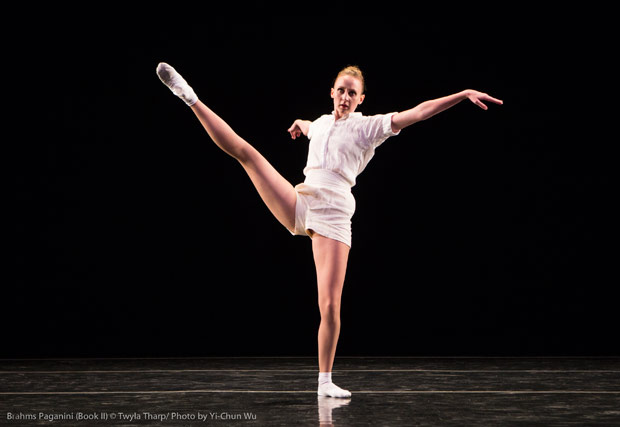
© Yi-Chun Wu. (Click image for larger version)
Twyla Tharp Dance
Twyla Tharp and Three Dances: Country Dances, Beethoven Opus 130, Brahms Paganini
★★★✰✰
New York, Joyce Theater
12 July, 2016
www.twylatharp.org
www.joyce.org
Every Step In the Book
Twyla Tharp is a kind of dance wizard – steps pour out of her like torrents in a waterfall. She has more ideas per square inch than some choreographers have in an entire career. It’s amazing to watch. That is, until you begin to wish she had one or two fewer ideas. If only she would slow down, just a little, and let you catch your breath.
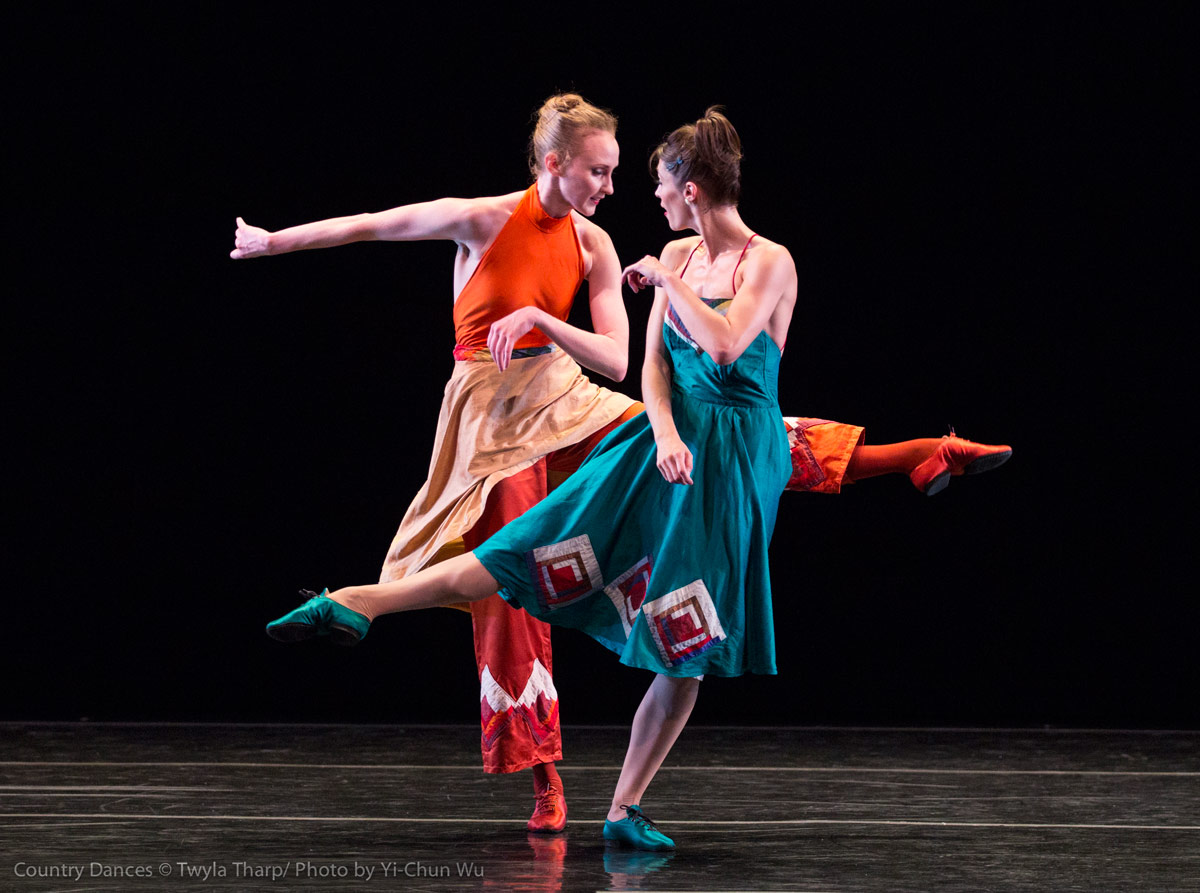
© Yi-Chun Wu. (Click image for larger version)
Her brilliant little ensemble of dancers, nine in all, is currently performing at the Joyce: the program consists of one piece from the seventies (Country Dances), one from the eighties (Brahms Paganini), and one new this year (Beethoven Opus 130). Tharp certainly has an eye for dancers. John Selya, a veteran Tharpian, is the eminence grise. He created the role of Eddie in Tharp’s long-running dancical Movin’ Out and you can’t help but like him. He’s a real guy’s guy, a cool customer, a gent. In Country Dances, a manic bluegrass piece that opens the show, he paces around the stage like he owns the place, gets down on the floor and does one-handed pushups, grinning like a cat all the while. Three ladies vie for his attention. Caitlyn Gilliland, formerly of New York City Ballet, is the gawky sylph with a body like taffy who can twist herself into any shape, then blow you away with a gorgeous, radiant Balanchinean arabesque. And she’s a cutup. You can easily see why Tharp loves her.
The other dancers are no less impressive, and endowed with impressive stamina. Brahms Paganini, set to Johannes Brahms’ Variations on a Theme by Paganini (for piano) begins with an astonishing solo for a man which much last a good ten minutes. How he survives it, I don’t know. Reed Tankersley dances it with casual aw-shucks charm, wearing preppy whites by Ralph Lauren. (The whole piece has a prep-school feel; the second half is like a sock-hop for the cheerleader squad and the track team.) That solo must contain every step in the book: beaten jumps, pirouettes to the floor, squats, sashays, dives, spins in which one leg flies through the air and then ricochets back in the opposite direction. And yet, it doesn’t feel relentless – to the audience – because it just meanders on, quietly, like a thought. It builds a groove, and invites you to come along. It doesn’t wear you down. Quite the contrary: it elates you.
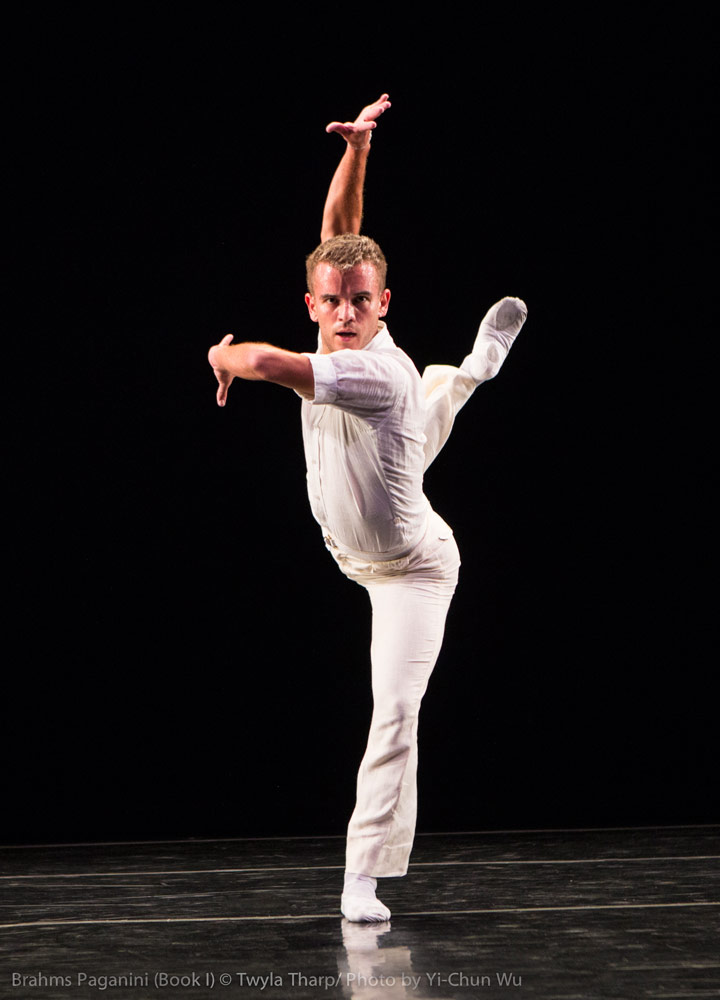
© Yi-Chun Wu. (Click image for larger version)
Unfortunately, too much of the choreography on this program has just the opposite effect, if the second half of Brahms Paganini reverts to cheerful, breakneck virtuosity; it’s packed with tricky lifts. There is huge dance intelligence, complication, and clarity at play, but it is just exhausting to watch. You wish isolated moments lingered longer, or returned again for a second look. You wish the dancers had a moment to breathe, to expand, rather than have to throw themselves into one spin or lift or jump or run after another. You wish they didn’t smile quite so winningly or so brightly. And you wish you had some mental space left to listen to the music.
This is especially true in Beethoven Opus 130, set to one of the late quartets. The music is extremely demanding in itself, at times verging on cacophony. Tharp overlays this with a furious profusion, filling the stage with five or six activities going on at once. The vocabulary is mostly balletic, but with Tharp’s usual vernacular twist. A guy taps a girl on the butt; another one slides halfway across the stage. But the tone is mostly serious, driven by an enormous fugue that multiplies in relentless waves. Once the fugue gets going, the dance struggles to keep up, without actually helping to make sense of the music.

© Yi-Chun Wu. (Click image for larger version)
Nevertheless, a few themes rise to the surface. Men crawl, bare chested, across the floor while a dominant, elusive woman (Caitlin Gilliland), steps over them, pushes them to the ground, manipulates them. Matthew Dibble, the central figure, seems to hold this woman in awe; more than once, he simply watches her, looking slightly overwhelmed by the sheer amplitude of her movement. Awe in part because she wears a beautiful sheer black dress over a black leotard. The black costumes, by Norma Kamali, are all gorgeous. Dibble is a seeker, yearning for something. His dancing is courtly, exploratory, and yes, impossibly difficult.
But it is a quiet solo for this man, a moment of meditative stillness amid the maelstrom, that stays in the mind. Would that there were more moments like this one.









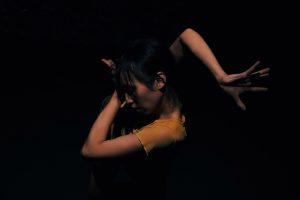
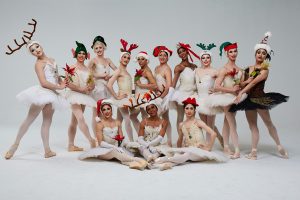


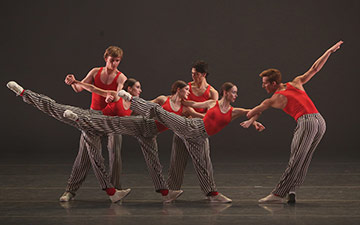

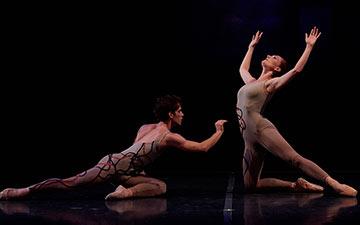
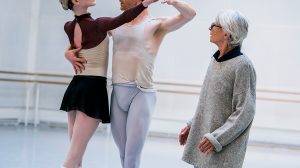
Harss writes with such clarion acuity. Such a pleasure to read and so clearly
capturing the spirit of what she sees. Bravo.
Thank you, Renee. What a compliment! 🙂